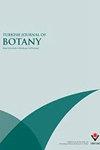eskilensis三棱子植物(菊科):土耳其安纳托利亚中部的一个盐生新种
IF 1.5
4区 生物学
Q3 PLANT SCIENCES
引用次数: 1
摘要
:在本研究中,描述了土耳其安纳托利亚中部的一个属的新种,Tripleurspermum eskilensis(菊科)。新物种是从埃斯基尔地区的一个禁区(阿克萨雷省)采集的。它生长在含盐的草原上,在形态特征上与德氏锥虫有密切的亲缘关系。它在形态上也与土耳其的盘状和盘状投降物种进行了比较。本研究包括其详细描述、诊断特征、原始照片、地理分布、栖息地和生态、保护状况和鉴定要点。从形态特征、花粉、瘦果形态解剖、气孔长度和分子系统发育分析等方面,对浙江三棱子植物与亲缘关系密切的物种进行了比较。本文章由计算机程序翻译,如有差异,请以英文原文为准。
Tripleurospermum eskilensis (Asteraceae): a new halophytic species from CentralAnatolia, Turkey
: In the present study, a new species of the genus, Tripleurospermum eskilensis (Asteraceae), is described from Central Anatolia, Turkey. The new species has been collected from Eskil region in a restricted area (Aksaray Province). It grows in salty steppe, and is closely related to T. decipiens in terms of morphological characteristics. It has also been morphologically compared with discoid and disciform capitulated species in Turkey. This study includes its detailed description, diagnostic characters, original photographs, geographical distribution, habitat and ecology, conservation status, and identification key. The comparison of Tripleurospermum eskilensis with closely related species was conducted in terms of morphological characteristics, pollen, achene morphology and anatomy, stomatal length, and molecular phylogenetic analysis.
求助全文
通过发布文献求助,成功后即可免费获取论文全文。
去求助
来源期刊

Turkish Journal of Botany
PLANT SCIENCES-
CiteScore
2.90
自引率
5.60%
发文量
31
审稿时长
6-12 weeks
期刊介绍:
The Turkish Journal of Botany is published electronically 6 times a year by the Scientific and Technological Research Council of Turkey (TÜBİTAK) and accepts manuscripts (in English) covering all areas of plant biology (including genetics, evolution, systematics, structure, function, development, diversity, conservation biology, biogeography, paleobotany, ontogeny, functional morphology, ecology, reproductive biology, and pollination biology), all levels of organisation (molecular to ecosystem), and all plant groups and allied organisms (algae, fungi, and lichens). Authors are required to frame their research questions and discuss their results in terms of major questions in plant biology. In general, papers that are too narrowly focused, purely descriptive, or broad surveys, or that contain only preliminary data or natural history, will not be considered (*).
The following types of article will be considered:
1. Research articles: Original research in various fields of botany will be evaluated as research articles.
2. Research notes: These include articles such as preliminary notes on a study or manuscripts on the morphological, anatomical, cytological, physiological, biochemical, and other properties of plant, algae, lichen and fungi species.
3. Reviews: Reviews of recent developments, improvements, discoveries, and ideas in various fields of botany.
4. Letters to the editor: These include opinions, comments relating to the publishing policy of the Turkish Journal of Botany, news, and suggestions. Letters should not exceed one journal page.
(*) 1. Raw floristic lists (of algae, lichens, fungi, or plants), species descriptions, chorological studies, and plant sociology studies without any additional independent approaches.
2. Comparative morphology and anatomy studies (that do not cover a family, tribe, subtribe, genus, subgenus, section, subsection, or species complexes with taxonomical problems) without one or more independent additional approaches such as phylogenetical, micromorphological, chromosomal and anatomical analyses.
3. Revisions of family, tribe, genus, subgenus, section, subsection, or species complexes without any original outputs such as taxonomical status changes, IUCN categories, and phenological and ecological analyses.
4. New taxa of all plants without any additional independent approaches such as phylogenetical, ecological, chromosomal, chorological and correlational analyses in addition to a detailed macro- and micro-morphological descriptions with quality field and microscopic illustrations of taxonomically important structures and identification key in the taxonomic group.
New records of all plants without any additional independent approaches such as phylogenetical, ecological, chromosomal, chorological and correlational analyses in addition to a detailed macro- and micro-morphological descriptions with quality field and microscopic illustrations of taxonomically important structures and identification key in the taxonomic group may be accepted for peer review if they contain 3 or more new records or taxonomical status update, such as lectotypification, new combinations, transfers, revivals and synonyms.
5. New taxa of algae, lichens, and fungi without any additional independent approaches such as phylogenetical, ecological, chromosomal, chorological and correlational analyses in addition to a detailed macro- and micro-morphological descriptions with quality field and microscopic illustrations of taxonomically important structures and identification key in the taxonomic group.
New records of algae, lichens, and fungi without any additional independent approaches such as phylogenetical, ecological, chromosomal, chorological and correlational analyses in addition to a detailed macro- and micro-morphological descriptions with quality field and microscopic illustrations of taxonomically important structures and identification key in the taxonomic group may be accepted for peer review if they contain 5 or more new records or taxonomical status update, such as lectotypification, new combinations, transfers, revivals and synonyms.
 求助内容:
求助内容: 应助结果提醒方式:
应助结果提醒方式:


